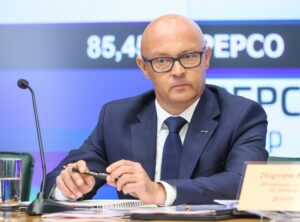The Via Carpatia and Rail Baltica projects will give Lithuania access to Western Europe. Poland is a natural gateway to the West for Lithuania, and has always been – said the Lithuanian Minister of Transport and Communications Rokas Masiulis in an interview for BiznesAlert.pl.
BiznesAlert.pl: In September at the Economic Forum in Krynica, we talked about the reconstruction of the Renge railway to the Możejki refinery. At what stage are the works today?
Rokas Masiulis: Last month, we signed a contract with the contractor, and work will start soon. We planned a meeting with the Polish Minister of Infrastructure Andrzej Adamczyk in Możejki in June. He will come to the construction site to see how the work is going on. They should be finished by the end of this year, but we are still talking with contractors, what may extend the work for several months. However, we are prepared that the end of the work will be finished at the end of the year.
And what is the future of the Via Carpatia project?
Via Carpatia will lead from the Polish border to Kaunas and further to the sea to Klaipeda. The connection of Klaipeda-Kaunas has already been completed some time ago, we have recently opened a section of the highway from Kaunas to Mariampol, the last infinite section between Mariampol and the border with Poland remained. Work on the last part should be completed by the end of 2022. According to our knowledge, the Poles have to finish their part in 2021. This means that by 2023 the northern part of Via Carpatia will be completed.
What do these infrastructure projects – Via Carpatia and Rail Baltica – mean for the Lithuanian economy?
They will give us access to Western Europe. Poland is a natural gateway to the West for Lithuania, and it has always been. Since the collapse of the Soviet Union, all our infrastructure projects have led to the West, through Poland i.e. highways, railways like Rail Baltica and aviation.
How is the development of aviation infrastructure in Lithuania?
We are expanding our two main airports: first of all, the Vilnius airport, where we create a new terminal to effectively increase its capacity for the next 10-15 years. The number of passengers is growing rapidly, so we are not sure if this will be the final stage of airport expansion. It may be necessary to make a decision either to enlarge the Vilnius airport or to build a completely new one, similar to the Central Transport Port project. It would differ from the Polish plan in that the airport itself would be created without a railway hub. Our old aviation infrastructure is slowly becoming more efficient, and the old airport is on the UNESCO World Heritage list, so it is forbidden to touch it (laughs).
Interview by Michał Perzyński








